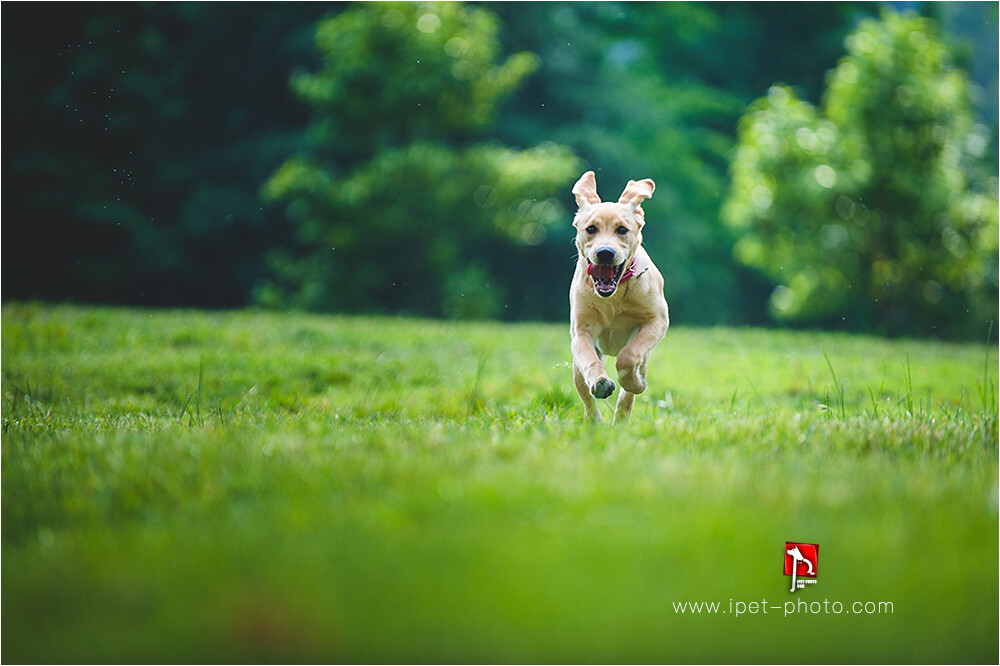Labradors are a breed known for being sweet, intelligent, loyal, and rarely aggressive – merely big lovers. But adding a Labrador to the family means being committed to providing the amount of exercise they need and deserve.
How Much Exercise Does a Labrador Need?
How much exercise a Labrador needs in a day will vary depending on their age. A puppy will need anywhere from 15-25 minutes of exercise per day, while an adult Lab will require anywhere from 40-120 minutes of exercise per day.
It’s essential to keep in mind that while Labradors are most commonly house and/or family pets, they still have the genetic makeup of a working dog. This makes exercise mandatory for your Labrador, as without it, dogs can become bored and start engaging in undesirable behavior. Regular exercise keeps furry friends happy, healthy, and calm.
How much exercise is needed to keep your Lab healthy and happy depends on their age. For instance, a puppy is still growing and developing and will require less daily activity, while an adult Labrador will need significantly more.

Labrador Puppies
How much exercise does a Labrador Puppy need? A simple way, and good rule in general, for determining how much daily exercise your Labrador puppy needs is 5 minutes per every month they’ve been alive.
So, if your puppy is three months old they will need about 15 minutes of daily exercise, at four months about 20 minutes of daily exercise, at five months, they will require roughly 25 minutes of daily exercise, and so on. This rule is encouraged until your pup reaches one year old.
Keep in mind that puppies still have tender bones that are still developing and little bodies that are still growing. Over-exercising as a puppy can lead to early bone and joint issues.
Beginning exercise with your Labrador at a young age creates a strong bond with your dog and encourages a happy, healthy lifestyle right from the start.
Adult to Senior Labradors
Exercise for adult Labradors is crucial for maintaining good health and keeping muscles and joints functioning while also managing their weight.
It is recommended that adult Labradors get roughly 20 – 30 minutes of exercise twice a day. Often, you won’t have to worry about too much exercise as adult Labs are more than happy to engage in any physical activity you throw at them.
As Labradors age, it’s important to keep an eye out for signs of aches and pains or signs that they are slowing down. Labradors are notorious for just wanting to please their owners, so it’s not uncommon that they will overexert themselves as they get older, which can lead to soreness and/or bone and joint issues.
A good way to ensure your Labrador will get the right amount of exercise is to consider your own lifestyle and tailor your needs. If you’re an active person that goes on daily walks or runs, take your dog with you. If you’re more laid back, consider other exercises for your pet, such as playing fetch or dock diving.
If your pet is being active and spending time with you, they’ll stay happy and healthy.

Best Ways to Exercise a Labrador
There are a ton of ways to make sure your Labrador is getting enough exercise, rain or shine. Don’t be afraid to get creative with exercises as Labradors are extremely flexible, and always remember to check with your vet before engaging in a strenuous or high impact activity.
Exercise Ideas for Puppies
Exercise for your Labrador puppy is essential. Early exercise helps them get on track for a lifetime of healthy living. It also helps to get out their energy so they remain more calm during training.
Exercises for Puppies
1.Walking. Taking your puppy on a walk is a great way to get in a few minutes of exercise and for both you and your puppy to get some fresh air. When taking your puppy on a walk, be sure to walk at a normal pace, stopping when your puppy sits and continuing once your puppy stands up again. Don’t stray too far from home to avoid over-exercising and putting a strain on developing bones and joints.
2.Running free. If you have a fenced-in backyard or access to a fenced-in dog park, letting your new furry friend run free is a wonderful form of exercise for energetic pups.
3.Swimming. At around three months, you can introduce your Labrador puppy to swimming by allowing him or her to wade in and play in low water. This is a great form of exercise for little ones because this type of exercise is low impact on tender joints.
4.Interactive Dog Toys. Interactive dog toys are great for rainy days, or anytime you find yourself stuck inside and need to exercise your puppy. Check out these recommendations:
- 1.Starmark Bob-A-Lot Interactive Dog Toy. This interactive dog toy will keep your pup busy, on the move, and comes with the added benefit of dispensing treats.
- 2.Hyper Pet Doggie Tail. This plush toy wiggles vibrates, and barks and is sure to keep your pup moving and entertained.
- 3.Woodland Friends Burrow Hide and Seek Toy. This large interactive toy puzzle includes three squeaky chipmunks that will keep your pup occupied.
5.Fetch. Labradors are natural retrievers, so this game will come naturally to them. An added benefit of fetch is this can be played indoors or outdoors. Remember to keep toys lightweight for small mouths.
Exercise Ideas for Adult Labradors
Here are our favorite ways to get moving with Adult Labradors. Be sure to mix it up so your dog has a variety of exercises. This keeps him interested and helps work out different parts of his body.
Hiking
Hiking is a great way to break out of the ordinary walk around the block. Before you go, check to make sure hiking trails are dog-friendly and check rules regarding leashes. Don’t forget a bowl for water, so your dog doesn’t become dehydrated, and after a long day of hiking, opt to give your trail buddy a warm, relaxing bath when you get home.
This COMSUN Collapsible Dog Bowl is great for taking on a hiking trip as they are durable, reusable, and can clip right on to your backpack, purse, or leash
Dog Parks
Labradors are naturally friendly dogs, so taking your dog to a dog park is a great way for your dog to run around free and get social. Be sure to check your local dog park rules before you visit.
If you’re unsure of where a dog park is in your city, there are a number of apps that can help with that. Here are a few apps that can help you find the perfect spot to take your furry friend.
- Dog Park Finder Plus – this app not only lists dog parks, but also includes a list of dog-friendly restaurants.
- Bark Happy – this app lists local dog parks, as well as, dog-friendly restaurants and hotels, and amenities offered at each one.
- Off Leash – Off-leash is a great app for not only finding nearby dog parks, but it also gives you all the details/rules of each dog park.
- PlayPal Dog Park Buddy – Another great app for locating dog parks, and PlayPal allows you to set up puppy play dates with your friends.
Swimming
Swimming is a great exercise for your Labrador and a great way for them to keep cool during hot summer months. Labradors are natural swimmers, and their coat allows them to dry quickly. If you don’t have a pool at home, you can take your dog to a dog-friendly lake or fill up a kiddy pool for them.
If your dog is new to swimming, take it slow by starting in shallow waters; and even if your dog is used to the water, remove their collar and be sure to keep an eye on them while swimming because accidents can always happen.
After a day of swimming, be sure to give your dog a bath to remove any dirt and/or chlorine from their coat.

Fetch
Fetch is a super fun game for you and your Labrador. Grab his or her favorite small, lightweight toy and head outside to your favorite park, or if the weather isn’t ideal for spending time outdoors, stay inside.
Due to their “retriever” instincts, Labradors usually LOVE playing fetch. You can spend and hour straight with some Labs and they never tire of this game.
Agility Training
Agility training is not only fun for your pet, but also helps you bond with them. Agility training can take place in your backyard, favorite local park, or even inside if the weather isn’t cooperating. In many areas, there are agility groups you can join if you’re new to this activity.
Agility courses can be set up using hula hoops, tunnels, and/or PVC pipes. There are some videos on YouTube that show how you can build agility equipment at home for under $50.
Walking or Running
Don’t underestimate how much your Labrador will enjoy a basic walk or run with you. If you’re a runner, don’t worry about your Labrador not being able to keep up with you, they typically don’t have a problem keeping up with their owners.
Hunting
Before your Labrador is ready to go hunting, there is a certain amount of training they’ll have to go through, but don’t forget, these dogs are hunters at heart, so once they’re ready, they’ll quickly fall in love with this form of exercise.

Hide and Seek
If you’re stuck inside on a rainy day, play some hide and seek with your Labrador. Find a way to distract them, perhaps with their favorite toy, then hide. Your dog will love running around the house trying to find you.
Dock Diving
If your Labrador just can’t get enough of the water, consider taking them dock diving. Dock diving is like fetch, just in the water. Throw your dog’s favorite float toy in the water and wait for them to jump in and retrieve it. Dock diving can be tiring, so be sure to look for signs of your dog becoming tired.
Laser Pointer
Another idea for some inside exercising is shining a laser around the house and allowing your dog to chase it. Just be sure not to point the laser in your dog’s eyes as this can cause damage to eyes.
Tug of War
Tug of war is a great game to play indoors or outdoors, and can be played with a variety of toys. The Goughnuts Tug Toy is a safe and tough option for a tug of war rope for your dog. Tug of war can trigger aggression in some dogs, so if you notice this type of behavior, discontinue this activity and choose another form of exercise.
Hiding Treats
If you’re looking for a way to keep your dog entertained indoors, hide a few treats around the house, and your dog will stay entertained and actively trying to find all the treats.
Signs Your Labrador Isn’t Getting Enough Exercise
Labradors require a certain amount of exercise each day. As a pet owner, you may wonder if your dog is getting the amount of physical activity they need. Here is a list of signs your dog may be exhibiting if he or she is not getting enough daily exercise.
- Weight Gain. Weight gain will occur if your dog is eating too much and not exercising enough. If you notice a significant change in your dog’s weight, consider how much food your dog is consuming versus how much exercise they’re getting. Consider increasing the amount of exercise your dog is getting, and also consult with your vet regarding a diet and exercise plan.
- Depression/Becoming Withdrawn. If your dog was once social but has become more withdrawn, they may not be receiving enough physical activity. Like humans, dogs require physical activity to maintain good physical and emotional health.
- Destructive Behavior. Suddenly engaging in destructive behavior such as chewing, getting into the trash, and/or increased aggression toward people or other dogs are all telltale signs of your Labrador not getting enough exercise.
- Excessive Barking or Whining. Dogs that aren’t receiving enough exercise will often begin to bark or whine to gain their owner’s attention.
- Hyperactivity. If you notice your Labrador becoming a little too excited when going outside and engaging in activities such as leash pulling or becoming difficult to control while on a walk, it may be time to increase how much exercise he or she is getting.
- Stiffness or Lack of Endurance. If your dog isn’t getting enough physical activity, they may become stiff, sore, and their endurance may plummet. It’s important to consult with your vet to address any underlying health conditions.

Conclusion
While Labradors are all around great dogs, it’s important to note they also require a certain amount of daily exercise to keep them both mentally and physically healthy.
Labrador puppies don’t require as much daily exercise as Labrador adults, but making sure puppies and adults are getting enough physical activity will strengthen your bond with your dog, keep muscles and joints functioning, and aid in maintaining their weight.
There are tons of ways to exercise your Labrador whether you can get outside or you’re stuck indoors, including hiking, swimming, hide and seek, dock diving, and agility training. Considering your own lifestyle and tailoring in your dog’s needs will help ensure they are getting the right amount of exercise.
If you’re concerned your dog may not be getting enough exercise, there are signs you can look for, such as excessive barking, weight gain, or depression. Always consult with your vet just in case there are underlying health conditions.
Now that you know how much exercise your Labrador needs and different ways you and your dog can get active, it’s time to get up and get out with your best furry friend.









